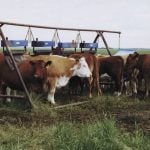There are a lot of ways to reduce losses to predators, but what works best and which ones are a good investment?
That’s what a multi-year pilot project in Manitoba is trying to determine.
Among the items being studied are:
- special penning, with seven strings of electric wire and predator-resistant gates.
- game cameras that give producers a better idea of what wildlife is passing through and that send photos to a smartphone.
- GPS collars to track cattle movements in the pasture and GPS ear tags that track livestock and send an alert when rate of movement implies animals are being chased.
Read Also

Lakeland College studying livestock wellness through cannulated heifers
Lakeland College’s Applied Research Team is working with six cannulated heifers on a handful of research projects.
There are also deadstock composting pens, meant to remove temptation for predators, and veterinary assessments, based on the idea that healthy animals are less attractive to predators.
As in Alberta, predation is a major issue in Manitoba. From 2015-19, the Manitoba Agricultural Services Corporation reported 1,417 to 1,619 cattle and 322 to 502 sheep taken annually by predators including wolves, bears or coyotes. Those numbers do not include cases where a carcass could not be found or when producers could not make an insurance claim.
The pilot project seeks to gauge the scope of predation — a sticking point for years in the livestock sector — and test potential mitigation strategies used in other regions.
“We’re exiting the setup phase and we’re starting to enter the evaluation phase,” said Ray Bittner, lead of the predation pilot project being spearheaded by Manitoba Beef Producers.
“So, producers who received some of these things will start commenting back to us. What worked? What didn’t work? What could be done to make it work better?”
One of the methods being tested is fladry wire, which is single-wire electric fence with streamers every 18 inches. The fencing is meant to deter canine predators (coyotes, wolves and foxes) and while not well suited for full-season protection, it can be used at vulnerable times such as calving season.
Fladry wire has been used to good effect in predation-heavy areas in the U.S., said Janine Wilmot, a provincial wildlife conflict biologist and member of the Livestock and Predation Working Group.
“It takes advantage of the wolves’ innate fear of novel situations and novel things on the landscape,” said Wilmot. “These flags flapping in the wind at these regularly spaced intervals, it’s just not something they’re used to encountering.”
The electrical component adds yet an extra layer of deterrent, but predators do get used to seeing those flapping flags so it is best used during strategic windows, she said.
One of the sites in the pilot is a community pasture near Ethelbert in the northwest corner of the province’s agricultural zone.
The pasture is no stranger to predators, mostly timber wolves and the occasional black bear, said manager Warren Jacobson. There can be as many as 35 to 40 kills in a grazing season, he said.
“You get bad years and better years. There’s always predation.”
Select cattle will be fitted with GPS collars under the predation pilot and the pasture now features a deadstock composting pen, said Jacobson, adding he has employed game cameras on the property for years.
“I think the collars would be a good idea because we have so much brush pasture,” he said. “It might help to see where the cattle are travelling or how quickly they’re being pushed from one end of the field to the other.”
The composting pen was not arduous to set up, he added, noting that getting deadstock to the pen will be the larger issue, given the rough landscape.
Not all installations at all test sites have been done, partly because there is a lot to consider.
“We’ve gone through some really productive discussions trying to understand all the complexities and nuances of the issue,” Wilmot said of the working group.
“It’s not a very straightforward issue. And it’s been a problem for centuries. It’s not a problem that we’re probably going to solve in the foreseeable future.”
But some of the technology may also give farmers a better chance of a payout for a loss.
GPS alerts in particular improve the odds of finding a carcass, said Wilmot, noting the provincial insurer requires a carcass and sufficient evidence that an animal was killed to process a payout under its wildlife damage compensation program.
“One thing I liked about them being able to track the movement of the livestock is that (the farmers) do receive an alert that indicates that they’re running for some unknown reason or whatever the case may be,” Wilmot said.
Adjusters require enough carcass to establish that an animal was attacked and was alive at the time of the attack, such as signs of a struggle. Producers can expect 90 per cent of an animal’s value in those cases.
Where cases are more dubious, such as if a carcass is too eaten to establish life at the time of attack, that coverage drops to 45 per cent of an animal’s value. Skeletons in the field, or lack of a carcass, lead to no payout.
— A version of this article first appeared in the Manitoba Co-operator.
















